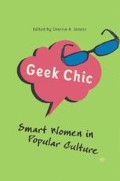Abstract
The women characters on the television show The West Wing are savvy, brilliant, and beautiful, and yet they constantly have to prove themselves. The story lines on the program reflect the bind in which intelligent women find themselves when they move into traditionally male-dominated fields, and the U.S. federal government is one of the most patriarchal of them all. Women in these professions need to be strong enough to go head-to-head with powerful male opponents and colleagues who consider women “aggressive” and “bitchy” if they are too assertive. If they are not direct enough, they are too “soft” and “weak.” If they are attractive and see themselves as sexual beings, they are viewed as “using their sexuality to get ahead.” If they are not perceived as beautiful, however, they are “threatening” and “manly.” This catch-22 facing smart women is nothing new. Feminist critics have made this point regarding the Anita Hill and Clarence Thomas hearings, the high-profile actions of Eleanor Roosevelt, the criticisms of Hillary Clinton, the media coverage of Dee Dee Myers, and the tenure of Condoleezza Rice as secretary of state. The more a woman’s politics support patriarchal, imperialist, and racist agendas, the more room she has to be prominent, but rocking the boat will always bring retaliation.
Access this chapter
Tax calculation will be finalised at checkout
Purchases are for personal use only
Preview
Unable to display preview. Download preview PDF.
Notes
John Fiske, Television Culture (London: Methuen, 1987).
Tania Modleski, Loving with a Vengeance: Mass Produced Fantasies for Women (Hamden: Archon Books, 1982), 112.
Fiske, Television Culture; Tania Modelski and John Fiske, Understanding Popular Culture (Boston: Unwin Hyman, 1989)
John Fiske, Media Matters (Minneapolis: University of Minnesota Press, 1994).
Donnalyn Pompper, “The West Wing: White House Narratives that Journalism Cannot Tell,” in The West Wing: The American Presidency as Television Drama, ed. Peter C. Rollins and John E. O’Connor (Syracuse, NY: Syracuse University Press, 2003), 17–31.
Stephen J. Farnsworth and S. Robert Lichter, The Mediated Presidency: Television News and Presidential Coverage (New York: Rowman & Littlefield, 2006).
For an analysis of the power of representation to shape public perception, see John Fiske, Power Play Power Work (London: Verso, 1993).
For an analysis of how women are portrayed in popular culture, see Marian Meyers, ed., Mediated Women: Representations in Popular Culture (Cresskill, NJ: Hampton Press, 1999)
Rosemary Betterton, ed., Looking On: Images of Femininity in the Visual Arts and Media (London: Pandora, 1987)
Janice A. Radway, Reading the Romance: Women, Patriarchy, and Popular Literature (Chapel Hill: University of North Carolina Press, 1984)
June Sochen, Enduring Values: Women in Popular Culture (New York: Praeger, 1987)
Susan J. Douglas, Where the Girls Are: Growing Up Female with the Mass Media (New York: Random House, 1994).
Judith Williamson, Consuming Passions: The Dynamics of Popular Culture (New York: Marion Boyars, 1986), 179.
Sherrie A. Inness, Tough Girls: Women Warriors and Wonder Women in Popular Culture (Philadelphia: University of Pennsylvania Press, 1999)
Susan Bordo, Twilight Zones: The Hidden Life of Cultural Images from Plato to O.J. (Berkeley: University of California Press, 1997).
Michel Foucault, Discipline and Punish (New York: Vintage, 1979)
Sandra Lee Barky, “Foucault, Femininity, and the Modernization of Patriarchal Power,” Feminism and Foucault: Reflections on Resistance, ed. Irene Diamond and Lee Quinby (Boston: Northeastern University Press, 1988), 129–154.
Rosemary Hennessy, “Queer Visibility and Commodity Culture” Cultural Critique 29 (Winter 1994–1995): 31–76.
For an analysis of the racialization of representation, particularly of black women, see Michelle Wallace, “Negative Images: Toward a Black Feminist Cultural Criticism,” in Cultural Studies, ed. Laurence Grossberg, Carrie Nelson, and Patricia A. Treichler (New York: Routledge, 1992), 651–671
bell hooks, “The Oppositional Gaze: Black Female Spectators,” in Feminist Film Theory: A Reader, ed. Sue Thornham (New York: New York University Press, 1999), 307–320
Gloria Anzaldua, “Haciendo caras, una entrada: An Introduction,” in Haciendo Caras/ Making Face, Making Soul: Creative and Critical Perspectives by Women of Color, ed. Gloria Anzaldua (San Francisco: Aunt Lute Books, 1990), xv–xxviii.
Mary Anne Borrelli, “The First Lady as Formal Advisor to the President: When East (Wing) Meets West (Wing),” Women & Politics 24.1 (2002), 25–45.
Christina Lane, “The White House Culture of Gender and Race in The West Wing: Insights from the Margins,” in The West Wing: The American Presidency as Television Drama, ed. Peter C. Rollins and John E. O’Connor (Syracuse, NY: Syracuse University Press, 2003), 32–41.
Michel Foucault, Power/Knowledge: Selected Interviews and Other Writings, 1972–1977, trans. and ed. Colin Gordon (New York: Pantheon, 1980).
Editor information
Copyright information
© 2007 Sherrie A. Inness
About this chapter
Cite this chapter
Berila, B. (2007). Savvy Women, Old Boys’ School Politics, and The West Wing. In: Inness, S.A. (eds) Geek Chic: Smart Women in Popular Culture. Palgrave Macmillan, New York. https://doi.org/10.1007/978-1-137-08421-7_10
Download citation
DOI: https://doi.org/10.1007/978-1-137-08421-7_10
Publisher Name: Palgrave Macmillan, New York
Print ISBN: 978-1-4039-7903-2
Online ISBN: 978-1-137-08421-7
eBook Packages: Palgrave Social & Cultural Studies CollectionSocial Sciences (R0)

